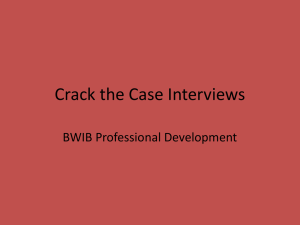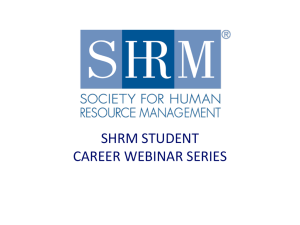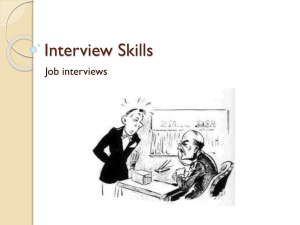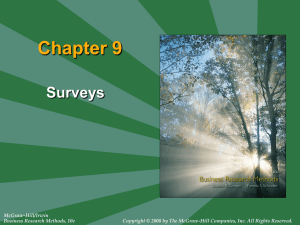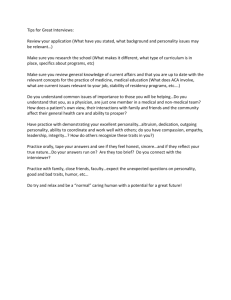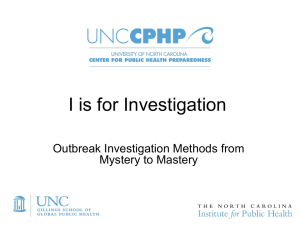Introduction
advertisement
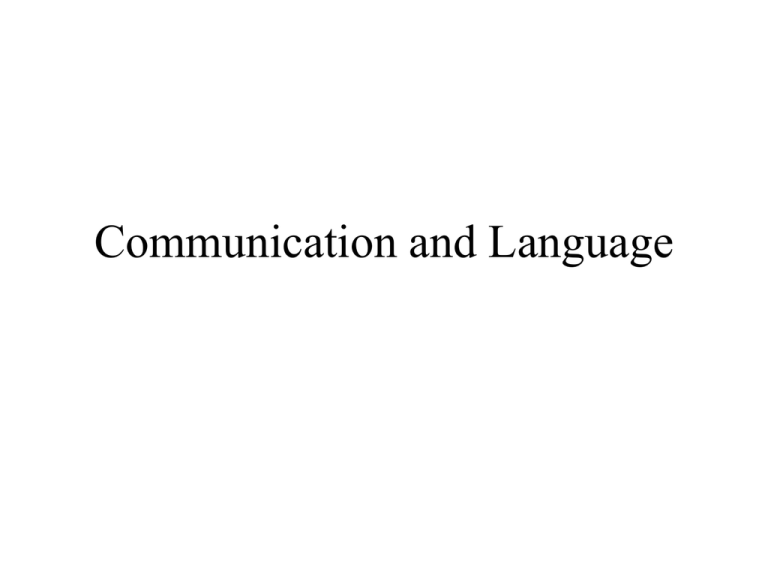
Communication and Language Introduction to language and communication • What is communication? – transmission of information – evoking understanding, meaning – maintaining social contact • What is language? – a system of human communication using words A conversation • • • • A: ‘What’s your name boy?’ B: ‘Dr. Poussaint. I’m a physician’ A: ‘What’s your first name, boy’ B: ‘Alvin’ Functions of communication Jacobson (1960) Context Message Addresser Addressee Contact Code Functions of communication (2) Context - Referential Message - Poetic Addresser Emotive Addressee Conative Contact - Phatic Code - Metalingual Interviewing Types of interview • Advice bureaux • At the bank • Tourism and travel services • Opinion polls • Telephone interviews – Selling – Surveys • Parent - teacher • • • • • • • Mass media interviews Job interviews Counselling Police Welfare services Clinical interviews Research interviews Class exercise - a short informal interview about “Being a good communicator” • • • • Divide into pairs Allocate role - interviewer / interviewee Plan the questions you will ask Conduct the interview and take note of answers • Review conclusions • Reverse roles and repeat The interview as conversation • Opening - Establishing rapport – Cognitive, social and emotional factors • • • • • Topic Development - maintaining attention Closing Attitudes - empathy, sympathy & judgement Ethics – – – – Interviewer credentials Anonymity and confidentiality Records Truth - content and purpose ‘True Conversation’ • A conversation is a process of two people understanding each other. ….each opens himself to the other person, truly accepts his point of view as worthy of consideration and gets inside the other to such an extent that he understands not a particular individual but what he says. • (Gadamer, 1975) Interview structure • Define topic • Question formats – Open-ended, multiple choice, ranking, probing – Bias, ambiguity, style of language • Leading questions – Source of bias, or test the limits • Question response sequence • Dealing with emotion • Prejudice Qualitative research interviews • Topic: Everyday lived life world • Interpret meaning of central themes • Qualitative • Open nuanced description • Specific situations and action sequences (not general opinions) • Deliberate naivité • Focused - neither structured nor non-directive • Ambiguity • Change and insight • Interviewer sensitivity • Interpersonal interaction • Positive experience Quality criteria for an interview • Extent of spontaneous, rich specific and relevant answers • The shorter the interviewer’s questions and longer the respondents answers the better • Degree to which interviewer follows up, clarifies meanings of answers • The ideal interview is to a large extent interpreted throughout the interview • The interviewer attempts to verify his interpretations of S’s answers in the interview • Interview is ‘selfcommunicating’ - story contained in itself not needing extra description and elaboration Hamlet’s interview with Polonius Act III Scene 2 H: Do you see yonder cloud that’s almost in shape of a camel? P: By th’ mass, and ‘tis like a camel indeed H: Methinks it is like a weasel P: It is back’d like a weasel H: Or like a whale? P: Very like a whale H: (aside) They fool me to the top of my bent Interpretation • Unreliable technique? - leading questions, different answers about clouds • Trustworthiness of Polonius - reliable, thrice checked answers. Indirect interview. Speaks for itself before aside • Power relations at a royal court. Courtier can be made to say anything, or ‘play up to’ the prince? • Part of a theme of the play - questioning reality, motives of others, frail nature of reality, pervasive doubt about the appearance of the world • Ethics - deception, no informed consent, but survival, life or death Qualification criteria for the interviewer • • • • • Knowledgeable Structuring Clear Gentle / permissive Sensitive • • • • • Open Steering Critical Remembering Interpreting Class exercise • How far did your interview match up to these criteria? • What were the problems? • How could you overcome these problems? • What were your findings? • What credibility do they have? • What can you say about this communication sequence? Contrasting Theories of Communication and Language 5 approaches to language and communication • • • • • Language as a formal system of grammar Language as the processing of information Communication as understanding Language as use Communication as a social skill Language as a formal system • Structural complexity of language • Rules of grammar, esp. syntax • Universal competence underlies performance • Acquisition through biological maturation not learning • Key texts: – Pinker Language as the processing of information • • • • • • Empirical experimental approach Information processing system Generic cognitive processes Sophisticated computational models Increasing attention to neurophysiology Key texts – Harley, Forrester Communication as understanding • Founded on semiotics - theory of signs • Role of reader/listener paramount in analysing signs • Meaning is a cultural production • Discourse and narrative • Key texts: – Forrester, Fiske, Bignell, Barthes Language as use • • • • • Shared understanding - common ground Co-operation and joint action Intentionality of participants is central Roles, relationships and social action Key text: – Clark Communication as a social skill • • • • Behavioural / ethnological approach Includes non-verbal communication Patterns of interaction (eg turntaking) Ecological structure of discourse – Interviews, lectures, chatrooms • Key text: – Hargie, Saunders & Dickson
